
1
African Lion
Panthera leo senegalensis
| 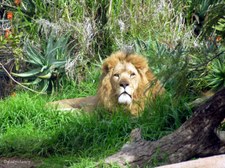
2
Lion from Central Africa
Panthera leo senegalensis
| 
3
Grant's Zebra from Eastern Africa
Equus quagga boehmi
|

4
Slender-tailed Meerkat from Southern Africa
Suricata suricatta
| 
5
Meerkat on Sentry Duty
Suricata suricatta
| 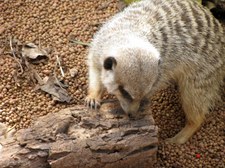
6
Meerkat chewing bark off log
Suricata suricatta
|

7
Playful Meerkat rolls over
Suricata suricatta
| 
8
Meerkat standing straight and tall
Suricata suricatta
| 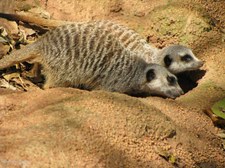
9
Meerkats about to enter Tunnel
Suricata suricatta
|

10
Meerkat from a different angle
Suricata suricatta
| 
11
Meerkat sitting in a hollow
Suricata suricatta
| 
12
Radiated Tortoise from Southern Madagascar
Geochelone radiata
|

13
Black-and-white Ruffed Lemur from Eastern Madagascar
Varecia variegata variegata
| 
14
Asian Small-clawed Otter leaving the Pool
Amblonyx cinereus
| 
15
Female Asian Elephants
Left: Permai (meaning pretty)was born in 1989 and arrived at Perth Zoo in 1992. Her back is arched more prominantly than Tricia's.
Right: Tricia is the oldest of our elephants and the matriarch of our herd. She arrived at Perth Zoo in 1963.
|

16
Tricia gathers hay in her Trunk
Elephas maximus
| 
17
Tricia holding bundle of Hay
Elephas maximus
| 
18
Tricia puts the Hay in her mouth
Elephas maximus
|

19
Australian Southern Cassowary
Casuarius casuarius
| 
20
Red Kangaroo enjoying the Sunshine
Macropus rufus
| 
21
Western Grey Kangaroos
Macropus fuliginosus
|

22
Goodfellow's Tree Kangaroo
Dendrolagus goodfellowi
| 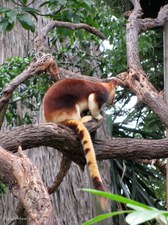
23
Goodfellow's Tree Kangaroo
Dendrolagus goodfellowi
| 
24
Durka the Dingo dozes on Rock while Keeper fills pool
(Canis lupus dingo) Sadly, Durka aged 15 years passed away in January 2011. RIP Durka.
|

25
Tasmanian Devil on the prowl
Sarcophilus harrisi
| 
26
Tasmanian Devil approaching
Sarcophilus harrisi
| 
27
Tasmanian Devil looks at the camera
Sarcophilus harrisi
|
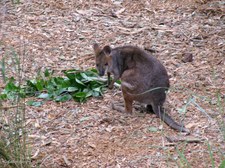
28
Tasmanian Red-legged Pademelon
Thylogale stigmatica
| 
29
Red-legged Pademelon eating leaves
Thylogale stigmatica
| 
30
Koala choosing fresh Gum Leaves
Phascolarctos cinereus
|

31
Koala chewing Gum Leaves
Phascolarctos cinereus
| 
32
Australian Pelicans in main Lake
Pelecanus conspicillatus
| 
33
Black-necked Stork or Jabiru
Ephippiorhynchus asiaticus
|

34
Jabiru in sitting position
Ephippiorhynchus asiaticus
| 
35
Australian Darter or Snake-bird
Anhinga melanogaster novaehollandiae
| 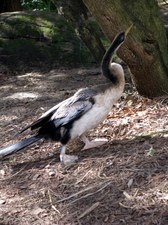
36
Australian Darter or Snake-bird
Anhinga melanogaster novaehollandiae
|

37
Australian Darter drying in the Sun
Anhinga melanogaster novaehollandiae
| 
38
Darter with water reflections
Anhinga melanogaster novaehollandiae
| 
39
Front view of Australian Darter
Anhinga melanogaster novaehollandiae
|

40
Two Pied Heron
Ardea picata
| 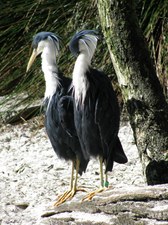
41
Pair of Pied Heron
Ardea picata
| 
42
Pied Heron
Ardea picata
|

43
Australian Shelduck
Tadorna tadornoides
| 
44
Great Egret and other waterbirds
Ardea alba
| 
45
Glossy Ibis in metallic red-brown Plumage
Plegadis falcinellus.
Australia's smallest Ibis.
|

46
Yellow-billed Spoonbill
Platalea flavipes
| 
47
Yellow-billed Spoonbill searching for Food
Platalea flavipes
| 
48
Two young Little Penguins
Eudyptula minor novaehollandiae
|
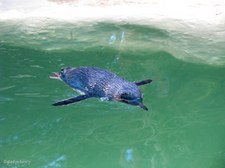
49
Little Penguin floating in the Penguin Plunge
| 
50
Baby Woma Python in Nursery
Aspidites ramsayi
| 
51
Adult Woma Python
Aspidites ramsayi
|
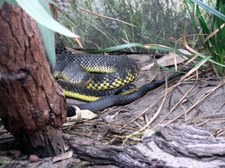
52
Tiger Snake (Notechis scutatus)
| 
53
Chameleon Dragon (Chelosania brunnea)
| 
54
Chameleon Dragon (Chelosania brunnea)
|

55
Fijian Crested Iguana (Brachylophus vitiensis)
| 
56
Trio of Australian Pelicans
Pelecanus conspicillatus.
Photos taken 1 August 2010.
| 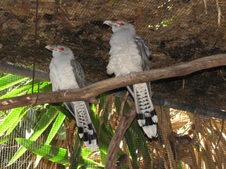
57
Channel-billed Cuckoo
Scythrops novaehollandiae. The favoured foods of the Channel-billed Cuckoo are native figs and native fruits, though some seeds, insects and even baby birds are also taken. The birds take figs from the tree with their massive bills.
|

58
Pair of Channel-billed Cuckoo
Scythrops novaehollandiae. The Channel-billed Cuckoo lays its eggs in the nests of the Australian Magpie, Gymnorhina tibicen, the Pied Currawong, Strepera graculina and members of the crow family (Corvidae). Unlike many other cuckoos, the young birds do not evict the host's young or eggs from the nest, but simply grow faster and demand all the food, thus starving the others. Often the adult female will damage the existing eggs in the nest when she lays her own and she may even lay more than one egg in a single nest.
| 
59
Blue-winged Kookaburra
Dacelo leachii. Blue-winged Kookaburras are found in tropical and subtropical open woodlands, paperbark swamps, timber on watercourses, clearings, canefields and farmlands.
| 
60
Blue-winged Kookaburra
Dacelo leachii. Blue-winged Kookaburras eat a wide range of invertebrates and vertebrates. They consume mainly insects, reptiles and frogs in the wetter months, and fish, crayfish, scorpions, spiders, snakes, earthworms and small birds and mammals at other times.
|
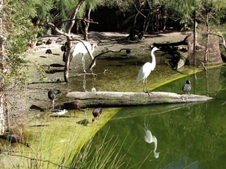
61
Australian Water Birds
| 
62
Great Egret
Ardea alba. The Great Egret usually feeds alone. It feeds on molluscs, amphibians, aquatic insects, small reptiles, crustaceans and occasionally other small animals, but fish make up the bulk of its diet.
| 
63
Brolga is a large Grey Crane
Grus rubicunda. The Brolga is a large grey crane, with a featherless red head and grey crown. The legs are grey and there is a black dewlap under the chin.
|
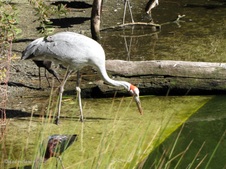
64
Brolga searching the shallows
Grus rubicunda. The energetic dance performed by the Brolga is a spectacular sight. Displays may be given at any time of the year and by birds of any age.
| 
65
Brolga standing Tall
Grus rubicunda
| 
66
Metallic Red-brown Glossy Ibis
Plegadis falcinellus. Glossy Ibis feed on frogs, snails, aquatic insects and spiders in damp places. They feed by probing the water and mud with their long, curved bill.
|
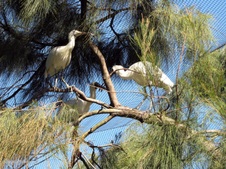
67
Spoonbills in the Tree Tops
Yellow-Billed Spoonbill on left and two Royal Spoonbills.
| 
68
Royal Spoonbills
Platalea regia. The Royal Spoonbill is a large white waterbird with black, spatulate (spoon-shaped) bill, facial skin, legs and feet.
| 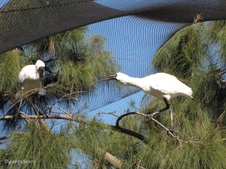
69
Royal Spoonbill bonding ritual
Platalea regia. The bird's impressive bill plays an important part in bonding rituals between males and females. She pecks in his direction and if he manages to nibble her bill, a bond is formed.
|

70
Yellow-Billed Spoonbill
Platalea flavipes. The Yellow-billed Spoonbill is a large, white waterbird with a yellow face and spatulate (spoon-shaped) bill, and yellow legs and feet.
| 
71
Yellow-Billed Spoonbill
Platalea flavipes. It is most often seen wading slowly in shallow waters, sweeping its bill from side to side to feed.
| 
72
Yellow-Billed Spoonbill
Platalea flavipes. During breeding season, the facial skin is outlined in black, the lacy outer wing plumes are tipped black and there are long hackles on its upper breast.
|

73
Blue-billed Duck
Oxyura australis. The Blue-billed Duck is almost wholly aquatic, and is seldom seen on land.
| 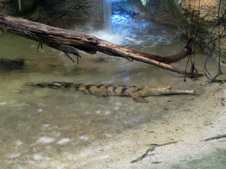
74
Freshwater Crocodile
Crocodylus johnstoni. Freshwater Crocodiles grow up to 10 feet (3m) long, but on average are about 1.5 metres long. They have a narrow snout, sharp teeth and webbed hind feet. The Freshwater Crocodile is generally brown in colour, however this will vary depending on their environment.
| 
75
Western Minnow
Galaxias occidentalis. Native freshwater fish of south-western Australia.
|

76
Saltwater Crocodile in new enclosure
Crocodylus porosus. The Saltwater Crocodile is usually found in deep, dark murky water. It may inhabit fresh or saltwater but is most commonly found in the brackish estuary areas of Northern Australia.
| 
77
Saltwater Crocodile
Crocodylus porosus. This Estaurine Crocodile is estimated to be about 60 years old.
| 
78
Carnaby's Black Cockatoo
Calyptorhynchus latirostris. This endangered Australian species is endemic to southwest Western Australia. Numbers have declined dramatically due to loss of habitat.
|
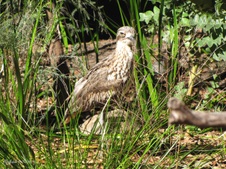
79
Bush Stone-curlew
Burhinus grallarius. The Bush Stone-curlew is a large, ground-dwelling bird of extraordinary grace and beauty. It is endemic to Australia and nearby islands. It was formerly known as the Bush Thick-knee.
| 
80
Bush Stone-curlew in Nest
Burhinus grallarius. During the day, Bush Stone-curlews tend to remain inactive, sheltering amongst tall grass or low shrubs and relying on their cryptic plumage to protect them from predators. When disturbed, they freeze motionless, often in odd-looking postures. For visual predators like raptors (and humans), this works well, but it serves little purpose with animals that hunt by scent such as foxes, dingoes or goannas.
| 
81
Bush Stone-curlew
Burhinus grallarius. Like most stone-curlews, it is mainly nocturnal and specialises in hunting small grassland animals: frogs, spiders, insects, molluscs, crustaceans, snakes, lizards and small mammals are all taken, mostly gleaned or probed from soft soil or rotting wood; also a few seeds or tubers, particularly in drought years. Birds usually forage individually or in pairs over a large home range, particularly on moonlit nights.
|

82
Black-winged Stilt
Himantopus himantopus. The Black-winged Stilt is a large black and white wader with long orange-red legs and a straight black bill. It has black on the back of the neck, a white collar and a red iris.
| 
83
Black-winged Stilt
Himantopus himantopus. Black-winged Stilts prefer freshwater and saltwater marshes, mudflats, and the shallow edges of lakes and rivers.
| 
84
Dingo drinking from the stream
The dingo is Australia's only native dog and is thought to have descended from wild Asian dogs.
|
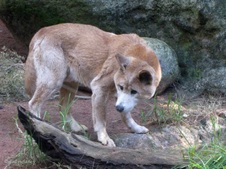
85
Australian Dingo
A dingo's colour is determined by where it lives. Golden yellow dingoes are found in sandy areas while darker black and tan dingoes are found in forests.
| 
86
Australian Dingo
Dingoes rarely bark. They howl at night to keep the family group together and to warn others to stay away.
| 
87
Sun Bear cub, Maly
Helarctos malayanus. Sun Bear cub, Maly, became the first Sun Bear born in Australia on 26 March 2008.
|

88
Male Sun Bear
Helarctos malayanus. Perth Zoo’s Project Sun Bear campaign raised over $330,000 to help build a new home at Perth Zoo for two rescued Sun Bears from Cambodia. They can be seen in the Asian Rainforest.
| 
89
Male Sun Bear watches his cub
Helarctos malayanus. Sun Bears have very short, smooth fur that varies from black to grey. They get the name ‘Sun Bear’ from the yellow rising-sun-shaped patch on their chest. Sun Bears have very long, curved claws which are helpful in tree climbing and extracting food from logs.
| 
90
Baby Sumatran Orangutan
Perth Zoo is considered a world leader in the breeding of the Sumatran Orangutan. The Zoo has successfully bred 27 orangutans since 1970 as part of an Australasian captive breeding program. In 2006, Perth Zoo released one of its female orangutans, Temara, into Bukit Tigapuluh National Park as part of a release program to re-establish a viable population of Sumatran Orangutans.
|
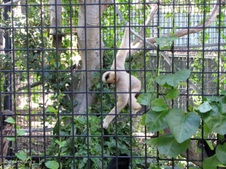
91
White-cheeked Gibbon
White-cheeked Gibbons are omnivores and spend most of their time looking for fruit in the canopy. However, they also eat leaves, flowers and insects.
| 
92
White-cheeked Gibbon
Male and female White-cheeked Gibbons have different coloured fur. The male’s body is covered with black fur, with white cheeks and a black crest on its head. The female is a golden colour with a black face and no crest.
| 
93
Closer to White-cheeked Gibbon
Perth Zoo is part of an Australasian breeding program for this species and has two breeding pairs of White-cheeked Gibbons.
|

94
Galapagos Tortoise
Galapagos Tortoises are one of the longest living animals. The oldest recorded tortoise is 175 years old.
| 
95
Alert Slender-tailed Meerkat
Suricata suricatta. Slender-tailed Meerkats live in large social groups of up to 30 members. While most of the group are out foraging for food, ‘sentries’ are posted as look-outs for predators such as eagles or cobras. Sentries stand on their hindlegs so they can get a better view of approaching predators. When a threat is sighted, the sentries let out an alarm and the meerkats dive into their burrows. When there is no threat, the sentries make a continuous low, steady peeping sound to let the group know they’re still on guard.
| 
96
Meerkat enjoying the Sun
Suricata suricatta. Meerkats are omnivores. They eat insects, spiders and other small animals, as well as roots and bulbs.
|

97
Rothschild's Giraffe family
Mother Misha and Father Armani with male calf born 29 May 2010.
| 
98
Rothschild's Giraffe baby calf
This male calf born on 29th May 2010 is the seventh giraffe to be born at Perth Zoo since 1995.
| 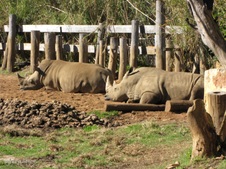
99
Southern White Rhinoceros
The Southern White Rhinoceros has a thick grey hide and two long horns on its snout. They also have a wide, straight upper lip. Their legs are fairly slim, allowing them to run up to speeds of 45 kpm, which is amazing for their size. Rhinoceros have poor eyesight but their sense of smell is very good.
|

100
Cheetah named Tokoloshe
The Cheetah is the world’s fastest land animal and can sprint at over 110 kph for 10–20 seconds. In December 2010, Tokoloshe the six-year-old female Cheetah returned to her home at Monarto Zoo in South Australia, to participate in the regional cheetah breeding program.
| 
101
Hamadryas Baboon
Hamadryas Baboons have a highly organised, unique and complicated social structure. A male will dominate up to 10 females at a time and form a ‘family’. Several families form a clan; several clans form a band; and several bands form a troop. The dominant male maintains these groups or ‘harems’ by threats and force.
| 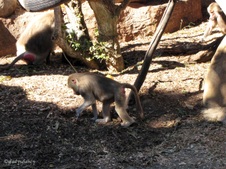
102
Young Hamadryas Baboon
Baboons are omnivores and eat grass, roots, tubers, seeds, nuts, fruit, insects and small animals.
|

103
African Painted Dogs
African Painted Dogs live in packs of 30 or more.
| 
104
African Painted Dog with wool hide
African Painted Dogs are carnivores and hunt large prey like wildebeest, zebra and impala.
| 
105
African Painted Dog
The African Painted Dog has long legs and a lean body, a relatively small head, large ears, and a short broad muzzle. Its coat varies in pattern and is a mixture of black, grey, yellow and white—hence the name.
|

106
Australian Pelican
Pelecanus conspicillatus.
Photos 9 August 2010.
| 
107
Pelican looking into the Water
| 
108
Pelican with raised Wings
|

109
Pelican drying feathers
| 
110
Pelicans on the Pond
| 
111
Australian Pelican is largest in World
|

112
Pelicans enjoying the Sun
The bill and pouch of pelicans play an important role in feeding. The bill is sensitive and this helps locate fish in murky water.
| 
113
Translucent Pelican Bill and Pouch
The pouch serves as a short-term collecting organ. Pelicans plunge their bills into the water, using their pouches as nets. When fully extended, the bill can hold up to 13 litres.
| 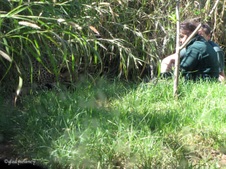
114
Please Enlarge to Look Closely
Two Keepers on the right sit and watch the Cheetah eating a meaty meal (under greenery on left)!
|

115
Rothschild's Giraffe reaches for a branch
| 
116
Rothschild's Giraffe close-up
| 
117
Grant's Zebra close-up
Equus quagga boehmi.
|

118
Grant's Zebra
Plains Zebra from Eastern Africa. Each zebra has its own individual stripe pattern.
| 
119
Rothschild's Giraffe Family
Mother Misha and Father Armani with male calf born 29 May 2010.
| 
120
Misha, Armani and Calf
Rothschild's Giraffe (Giraffa camelopardalis rothschildi).
|
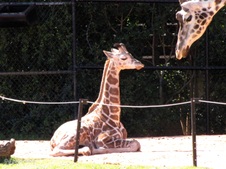
121
The calf Ajali with father Armani
The calf has been named Ajali, the Swahili word for destiny.
| 
122
Ajali is growing quickly
Aged 10 weeks when photo taken 9 August 2010. Update: April 2011, Perth's youngest giraffe Ajali left his home at the Perth Zoo to travel cross country to his new residence and new friends at Werribee Open Range Zoo in Victoria.
| 
123
African Flora in African Savannah Area
Ochna species. This plant has beautiful fragrant yellow flowers in spring and very attractive fruits.
|

124
African Flora in African Savannah Area
Ochna species, known as Mickey Mouse Plant, Bird's Eye Bush, or Carnival Bush.
| 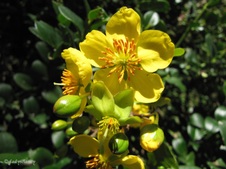
125
African Flora in African Savannah Area
Ochna species. This plant has beautiful fragrant yellow flowers in spring and very attractive fruits.
| 
126
African Flora in African Savannah Area
Ochna species. This plant has beautiful fragrant yellow flowers in spring) and very attractive fruits. These are shiny black and berry-like, suspended below bright-red sepals in a way that resembles the face of Mickey Mouse, hence the common name Mickey Mouse bush. The flowers are attractive to bees and butterflies. The ripe fruits are eaten by birds. Leaves with sharp teeth are long and narrow
|

127
African Flora in African Savannah Area
Fruit of the Ochna species. The ripe fruits are eaten by birds.
| 
128
African Flora in African Savannah Area
Sharp Thorns!
| 
129
African Flora in African Savannah Area
Ochna species. Fruits are shiny black and berry-like, suspended below bright-red sepals in a way that resembles the face of Mickey Mouse, hence the common name Mickey Mouse bush.
|

130
African Flora in African Savannah Area
Yet to be identified.
| 
131
African Flora in African Savannah Area
Yet to be identified.
| 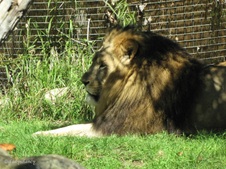
132
Lion in the shadows
He would not turn to look at the camera!
|

133
Sumatran Tiger is a solitary animal
| 
134
Southern White Rhinoceros
Adult Male.
| 
135
Calf born at Perth Zoo 2006
Southern White Rhinoceros.
|

136
A True Australian
20 January 2011.
Kangaroo at Perth Zoo.
| 
137
Western Grey Kangaroo
Macropus fuliginosus
| 
138
Kangaroo eating fresh 'greens'
Macropus fuliginosus
|

139
Kangaroo waiting and listening
Macropus fuliginosus
| 
140
Kangaroo standing straight and tall
Macropus fuliginosus
| 
141
Kangaroo about to jump away
Macropus fuliginosus
|

142
Sadness at Perth Zoo
20 January 2011. Durka the 15 year-old Dingo will be sadly missed by all visitors to Perth Zoo.
| 
143
Koala perched in tree
Phascolarctos cinereus
| 
144
Contented Koala at Perth Zoo
Phascolarctos cinereus
|

145
Looking into the Echidna burrow
Tachyglossus aculeatus
| 
146
Australian Darter
Anhinga novaehollandiae.
| 
147
Australian Darter
Anhinga novaehollandiae.
|
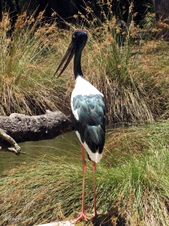
148
Black-necked Stork or Jabiru
Ephippiorhynchus asiaticus
| 
149
Black-necked Stork hunting
Ephippiorhynchus asiaticus
| 
150
Black-necked Stork spied something in the grass
Ephippiorhynchus asiaticus
|

151
Brolga standing on one leg
Grus rubicunda.
| 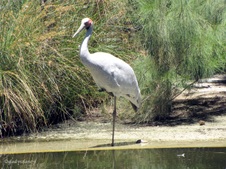
152
Brolga is a Grey Crane
Grus rubicunda.
| 
153
Brolga portrait
Grus rubicunda.
|

154
Black-winged Stilts resting
Himantopus himantopus.
| 
155
Trio of Little Penguins
Eudyptula minor novaehollandiae.
| 
156
Sun Bear from the Asian Rainforests
Helarctos malayanus.
|

157
Bear displays yellow rising-sun-shaped patch on chest
Helarctos malayanus.
| 
158
Bright Red Flowers (unidentified)
The Botanic Gardens at Perth Zoo have many exotic species.
| 
159
Eye-catching flowers
This tall unknown tree growing in deep shade, blossomed with bright red flowers.
|

160
Climbing the Ropes
25 April 2011.
Sumatran Orangutan at Perth Zoo.
| 
161
Orangutan Treat
25 April 2011. This Sumatran Orangutan at Perth Zoo picks up a large Ice Block containing frozen fruit.
| 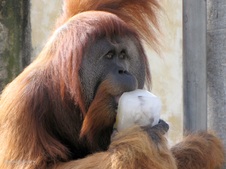
162
Enjoying an Ice Block
25 April 2011. Sumatran Orangutan at Perth Zoo.
|
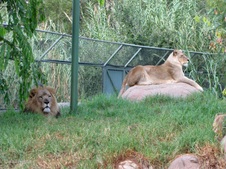
163
Lion and Lioness
| 
164
Lioness dozing in the sun
| 
165
Lion keeps watch
|

166
Galapagos Tortoise
Galapagos Tortoises are the largest tortoises in the world.
| 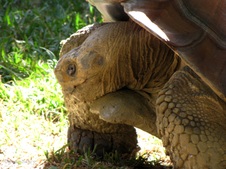
167
Galapagos Tortoise
Tortoise taking a stroll.
| 
168
Cheetah named Kifani
Kifani is 10 years old and recently arrived from Monarto Zoo.
|

169
Black-capped Capuchin
The Black-capped Capuchin is found in the rainforests of Central America, is an omnivore and eats nuts, fruit, insects, frogs, lizards and small bats
| 
170
Bush Stone-curlew is a ground-dwelling bird
| 
171
Meerkat comes from Southern Africa
|

172
Purple-crowned Lorikeets
Glossopsitta porphyrocephala.
A small parrot 17-18 cm in length.
| 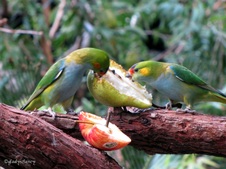
173
Purple-crowned Lorikeets eating fruit
| 
174
Cave-dwelling Frog (Litoria cavernicola)
Like many frogs in the Kimberley, the Cave-dwelling Frog may be threatened with extinction if the Cane Toad invades their habitat. Perth Zoo is the first to breed this species in captivity.
|
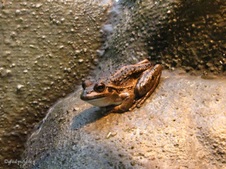
175
Motorbike Frog (Litoria moorei)
These frogs are often seen and heard around Perth. Motorbike Frogs come in different colours, from dull-olive to bright-emerald. They get their name from their call, which sounds just like a motorbike changing gears.
| 
176
Perth Zoo goes Solar
As part of its commitment to conservation and sustainability, Perth Zoo has harnessed the power of the sun to become Perth's largest solar site.
| 
177
Some of the Inverters for this 90.9 kW installation
The installation of 303 panels across eight Zoo buildings, make it the largest solar site in the city.
|

178
Sun-Day School
Twenty one solar panels adorn the roof of the Discovery and Learning rooms.
| 
179
Solar Panels on the roof of the Discovery and Learning rooms
This section produces on average 25 kWh of energy per day, which is more than enough to power the energy needs of an average house in Perth.
| 
180
Who's New at the Zoo?
25 July 2011:
Two Dingo pups, born 13 March 2011, are brother and sister pure-breed Alpine Dingos who were born at the Australian Dingo Conservation Association in New South Wales.
|

181
Dingo Pup approaches
This female has been called Mirri, which means wild dog.
| 
182
Mirri comes closer
Pure breed Alpine Dingo pup born 13 March 2011.
| 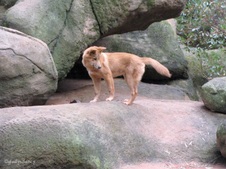
183
Mirri looks for her brother
As she starts to climb the rocks, Mirri looks back for her brother who is hiding behind other rocks. The male pup has been called Daku, which means sand.
|
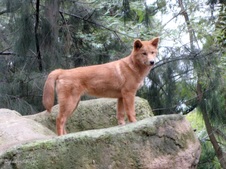
184
Mirri is four months old
Australian Alpine Dingo.
| 
185
Another glance to Daku below
Unfortunately, Daku would not come out to have his photo taken.
| 
186
Mirri relaxes perched high on the rock
|
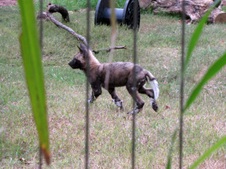
187
First glimpse of African Painted Dog pups
The highly threatened African Painted Dog has had its numbers boosted with the birth of nine pups at Perth Zoo.
| 
188
Two African Painted Dog pups in the grass
The pups were born late May 2011.
| 
189
Mother Mara and pup
The tri-coloured pups spent their first few weeks of life under the watchful eye of their mother, 7-year-old Mara, inside the den where Mara gave birth.
|

190
African Painted Dog, Mara
| 
191
Portrait of Mara
African Painted Dog and mother of nine pups.
| 
192
African Painted Dogs
Perth Zoo now has five adult males, one adult female and nine pups.
|

193
The Pups are very Active
Taken from the viewing platform.
| 
194
African Painted Dog pups
| 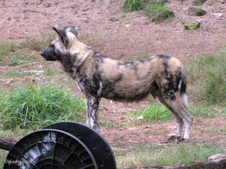
195
Male African Painted Dog
The adult male pack members have been regurgitating their meals to help feed the pups and Mara. This is natural behaviour that ensures the young develop and become part of the group.
|

196
Female African Painted Dog and two pups
| 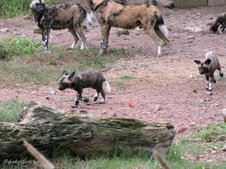
197
Parents watch the Pups at play
| 
198
The Pups at Play
|